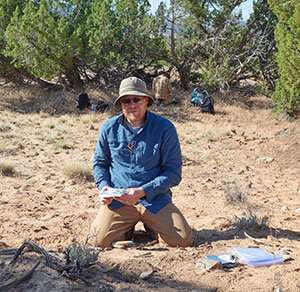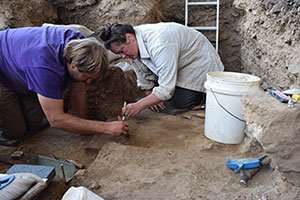Study shows synchronous human energy consumption over the past 10,000 years

University of Wyoming researchers contributed to a study that begins to fill in the knowledge gap of whether human societies grow and decline at the same rate and at the same time.
Erick Robinson, a postdoctoral researcher in UW's Department of Anthropology, and Robert Kelly, a UW professor of anthropology, were part of a study in which a group of anthropologists and sustainability scientists analyzed radiocarbon data going back over 10,000 years—throughout the entire Holocene period—and over four continents.
"We analyzed historical and radiocarbon records to identify synchrony in energy consumption," Robinson says. "Historical records provided information on energy consumption in eight countries since 1880, while radiocarbon records provided estimates of energy consumption in societies from four continents over the past 10,000 years. Energy consumption oscillated at a similar rhythm across both the radiocarbon and historical records."
Radiocarbon dating is the most common method of dating archaeological sites of the past 10,000 years. Synchrony is defined as when changes in the attributes of populations coincide over space and time. When populations synchronize, adverse changes in ecoystems and social systems may cascade from society to society.
Robinson and Kelly are co-authors of a paper, titled "The Synchronization of Energy Consumption by Human Societies throughout the Holocene," that was published Sept. 17 (Monday) in the Proceedings of the National Academy of Sciences (PNAS). The journal is one of the world's most prestigious multidisciplinary scientific serials, with coverage spanning the biological, physical and social sciences.
Jacob Freeman, a human ecologist and an assistant professor of anthropology at Utah State University, was the paper's lead author. Other contributors to the paper were from the University of Central Florida and Arizona State University; the Center for Climate and Resilience Research and the Center of Applied Ecology and Sustainability, both in Santiago, Chile; and the Far Western Anthropological Research Group Inc.
"This is the first quantitative comparison of archaeological radiocarbon time-series at a global scale. Until this study, archaeology has approached cultural differences, over time, to be the result of different social and environmental contexts in different regions of the world," says Robinson, of Miami, Okla. "This study shows that, when we zoom out to long millennial time-scales and then compare records at large global scales, the growth of populations on Earth was actually synchronized due to processes similar to what we now call 'globalization.'"

The degree of this rhythmic synchrony decreased with distance, with records from the same continent exhibiting greater synchrony than those from different continents, according to the paper. The decline in synchrony with distance suggests that synchrony in both ancient and modern societies is driven by interactions such as trade, migration and conflict. The results further suggest that the process of globalization may not be a new phenomenon but is, instead, a natural consequence of human societies evolving toward increased carrying capacity, according to the authors.
Robinson says he collected, with Kelly and the help of numerous colleagues and UW students, much of the radiocarbon data in the U.S. for this paper through a six-year, National Science Foundation (NSF)-funded grant for a project called "Populating a Radiocarbon Database for North America." He adds that the two previously published a paper in PNAS that laid the foundation for this current paper.
"For this paper, we used individual radiocarbon dates derived from samples such as charcoal, bone, shell, etc.," Robinson says. "These are scraps from tens of thousands of individual energy consumption events of humans over the past 10,000 years. We basically took the scraps from the past to build a better picture of it."
The paper's results demonstrate the potential for archaeological radiocarbon records to serve as a basis for millennial-scale comparisons of human energy dynamics and provide a baseline for further cross-cultural research on the long-term growth and decline trajectories of human societies.
"The research helps societies today because, in order to develop policies that favor the sustained use of resources, we must understand the processes that cause the synchrony of human populations," Robinson says. "The financial crisis of 2007-08 is a good recent example. The more tightly connected and interdependent we become, the more vulnerable we are to a major social or ecological crisis in another country spreading to our country. The more we are 'synced,' the more we put all our eggs in one basket, and the less adaptive to unforeseen changes we become."
Robinson has worked on the NSF radiocarbon project since its inception in 2014. He is co-leader, with Freeman, of the Past Global Changes (PAGES) working group, from which this research emerged. The working group is called Paleoclimate and the Peopling of the Earth (PEOPLE 3000).
"As an anthropological archaeologist trained to search for the uniqueness of each region and culture, this is very exciting because it shows that, when we take a broader perspective, we are still interdependent on others, no matter our cultural differences," Robinson says. "This paper shows that, in order to answer some of the central questions about the development of humanity, and to take on some of the central challenges facing contemporary societies, we must move back and forth between different spatial and temporal scales in order to understand the whole picture."
More information: Jacob Freeman et al. Synchronization of energy consumption by human societies throughout the Holocene, Proceedings of the National Academy of Sciences (2018). DOI: 10.1073/pnas.1802859115
Journal information: Proceedings of the National Academy of Sciences
Provided by University of Wyoming




















